-
KYRIE (Shunji Iwai 2023)

HAKUTO MATSUMURA, AiNA THE END AND HIROSE SUZU IN KYRIE
SHUNJI IWAI: KYRIE (2023)
Pop stars in a complicated 3-hour saga about street musicians marked by the 2011 earthquake and tsunami
Wendy Ide, Screen Daily: "Homeless street musician Kyrie (AiNA THE END) catches the eye of blue-wigged party girl Ikko (Hirose Suzu) one October night in Tokyo, 2023. It’s not just Kyrie’s raw talent that Ikko recognizes, but a shared past – a teenage friendship from a time when both girls had different names. Shunji Iwai’s music-driven melodrama weaves together multiple timelines, from 2011 until the present day, and a sprawling story that takes in earthquakes, bereavement, teen pregnancy and multiple instances of photogenic yearning. For the first couple of hours, it’s an engrossing piece of storytelling – the movie equivalent of a pulpy page-turner or an airport novel. The final third, however, starts to get a little bogged down with lengthy exposition and numerous tear-sodden emotional climaxes. Still, the music – the film’s key selling point – is distinctive and frequently rather lovely."
Letterboxd: Review by lll ★★. "When Shunji iwai and Makoto Shinkai wanted to revisit the trauma brought by the 2011 earthquake but instead they both made movies that fetishize young women who fall in love with someone played by Hokuto Matsumura."
Mark Schilling, THe Japan Times: "The story, which traces Kyrie’s tempestuous life over 13 years, unfolds on four different alternating and intersecting tracks. One focuses on Luca, a girl who was orphaned in the Great East Japan Earthquake and finds support from a kindly teacher, Fumi Teraishi (Haru Kuroki).
Another follows Luca as a lonely teenager (Aina The End) in Obihiro, Hokkaido. Though she speaks in whispers, she can sing like an angel. She is befriended by Maori (Suzu Hirose), a classmate whose mom runs a small bar. A rebellious type, Maori dreams of escaping Obihiro and moving to the big city.
We also meet the adult Luca (Aina The End again), who now calls herself “Kyrie.” Homeless and still barely articulate, she is busking on the streets of Tokyo when she is approached by Ikko (Hirose again), a mysterious woman in a blue wig, who offers to be her manager.
Connecting these plot threads is Natsuhiko Shiomi (Hokuto Matsumura), who was engaged to Luca’s older sister. Following her death in the 2011 disaster, he searches for Luca and finds her under Fumi’s protection in Osaka. After child welfare workers spirit the girl away, he manages to stay in off-and-on contact with her, while even becoming Maori’s tutor — all the while feeling guilty for not better protecting Luca and her sister.
There is much more to the over-packed plot, including Kyrie’s quick climb up the music industry ladder while never escaping the streets."
I can't say I could fully follow this film from scene to scene with its shifting multiple plot lines and chronology, but it is nonetheless a compelling watch, especially when it takes us right through two lovers experiencing the 2011 Great East Japan Earthquake and tsunami apart, but joined by cell phone as it is terrifyingly happening. If only the filmmaker didn't allow tragedy to drift into sentimentality at times. An overlong but impressively ambitious effort lightened up by a string of songs performed live by the musician characters and pop stars playing them.
Kyrieキリエのうた, 178 mins., debuted at Busan Oct. 5, 2023. Released in Japan, Hong Kong, and South Korea (twice) Oct.-Nov. 2023. Screened for this review as part of the 2024 New York Japan Cuts series (Jul. 10-21).
Last edited by Chris Knipp; 06-28-2024 at 01:05 AM.
-
RETAKE (Kota Nakano 2023)
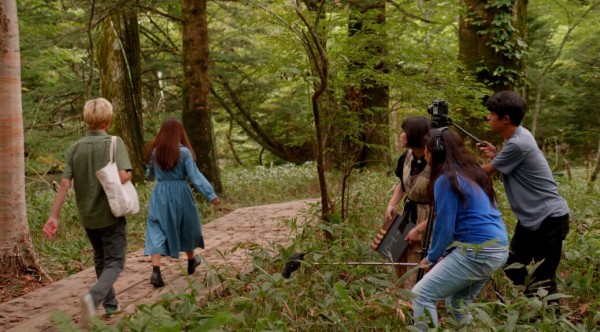
KOTA NAKANO: RETAKE (2023)
A simple film about high school kids making a film becomes something a more complex through the use of multiple "takes"
It's the summer holidays. The energetic, grownup Yu (Urara), with her glittering, Katharine Hepburn smile, sees her boyish, wide-eyed, and enamored high school classmate Kei (Yut‚ MutŰ) shooting her across a bridge with his camera and recruits him to shoot a film she wants to direct as a school project. Kei recruits JirŰ (RyŻsei Chiba), who's artistic, to play a boy who draws and Yu makes him the main actor in her film along with Umi (Nako ‘hara) playing a girl Jiro's interested in. They get Yu's guitar bandmate Arisa to record the sound. In the film, Umi will accompany Jiro to a land where time stands still so he can draw the girl, who is always in motion. They're making a movie about making a movie - or somebody is. But the first run-through is only the beginning.
Initially, these five young people are cute; they're having fun. There is a sense of enjoyment in being out in nature in lovely weather. They spend a lot of time by a roaring stream and waterfall. The roaring water becomes a character in itself, perhaps the most dynamic one.
After about 44 minutes, the film goes back over the filmmaking again, this time adding more detail and different angles to the original shots, and adding new shots or scenes. This is after Yu has told Kei on the phone that she's not coming back to direct because she finds the others too unmotivated. After this conversation, Kei says "Cut!" and gets up and comes toward the camera to turn it off. The next shot is of the actor who plays Kei, Yut‚ MutŰ, watching this previous shot on a screen. The meta POV has been established.
But we then move forward to other takes of earlier action. A chat between Arisa and Kei reveals that they may both see Yu as somewhat arrogant, though Kei is always easygoing and unflappable with her. He's a bit wishy-washy too, never having much of an opinion, for instance, about what to do the film's "last scene". Is Yut‚ MutŰ the dullest actor or the best actor in the film?
From the beginning, the filmmaking is so simple the line between life and "art" begins to dissolve quite quickly. Four of the five assemble into two couples. Kei is interested in Yu, though when she gets tired and overwhelmed with the filmmaking and rests her head on his chest he doesn't know what to do. Going around together for the film shoot, JirŰ and Umi begin to like being together. Yu takes Kei later, just the two of them, "location scouting," to more rushing water, another setting, a train ride away, of natural beauty.
Yu and Kei differ on several things, and Kei defers to her, but she startles him at one point back at school by leaving him to finish the editing by himself. He films her with Umi in the music room recording a composition for the film score. Then Yu has an idea for the "last scene" that turns out to be dangerous. As a Letterboxd writer says, the film "doubles and triples back on itself.
One idea for the final sequence leads to a mishap, though apparently after the victim recovers, the little team commits to resuming the shoot. It would have been possible to introduce haunting, creepy variations in the manner of a Michael Haneke film. But this is not Kota Nakano's aim here. In fact, after the same moment when Yu says she's happy and Kei agrees and she wonders what the "last scene" should be is repeated for a Take 4, a Take 5, a Take 6 and a Take 7, all nearly identical, we're ready not just to yell "Cut!" but "Enough, already!" But some clumsiness in the editing notwithstanding, the line between reality and illusion has been broached and this is the kind of festival film that pleases people in search of tricky screenplays.
Retake リテイク, 110 mins., debuted at Tokyo (Pia Film Festival) where it won the Grand Prize
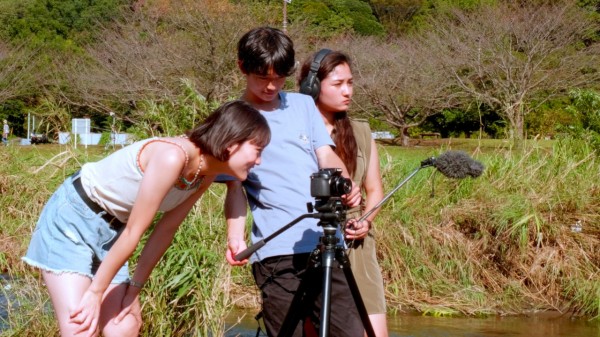
URARA, YUT¬ MUT‘, AND NAKO ‘HARA IN RETAKE
Last edited by Chris Knipp; 06-25-2024 at 05:17 PM.
-
CHOKE (Gen Nagao 2023)
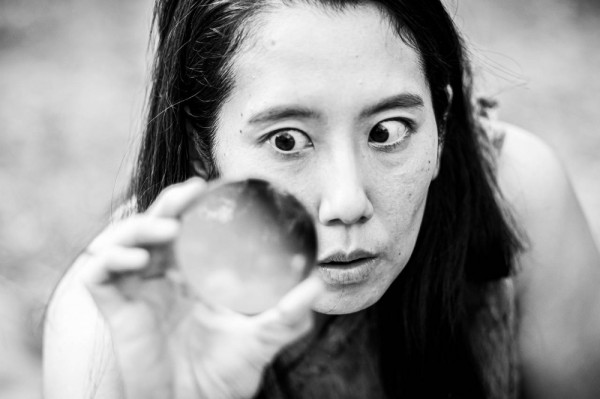
MISA WADA IN CHOKE
GEN NAGAO: CHOKE (2023)
(Reviewed by Mark Schilling in The Japan Times.
Woman meets boy
In this black and white semi-comical film a post-apocalyptic scene is focused mainly on a woman (Misa Wada) who fends for herself, living in the ruins of a vast dwelling. Nobody can speak, so the Japanese actors are able to show off their skill at mime. The woman, as a blurb puts it, " woman finds small joys in her daily survival routine of hunting and gathering." Things change when a male teenager (Daiki Hiba) turns up and takes an interest in her. Everything is accompanied by loud orchestral music.
He turns out to be a better homemaker than she is when to please her he comes up with a freshly killed baby rabbit and a meal full of unspecified but apparently delicious food. After they've been around each oher a while she starts grabbing him and they have through-the-motions sex and later hug and kiss, standing up. The inappropriateness of this relationship goes unrecognized. Choices may be limited.
There is an elderly trader who comes around from time to time to barter for goods. AS Mark Schilling pus it in his Japan Times review, "they swap slices of dried meat as though they were Pokemon trading cards." It's not clear what his true value is except for providing a magnifying glass usable to start a fire, which is later broken by nearby toughs who come and mess things up.
One of them has a prolonged fight with the teenager. Daiki Hiba puts a lot into this combat which is violent but, in keeping with the whole film, is semi-comical, except the teenager gets a wounded foot. It's one of the film's liveliest and most entertaining moments. Things get stranger after that. The boy pointlessly torments an older gown-wearing man, who later is put in a cage. Then the woman has the boy in another adjoining cage. He has been getting too dominant, no doubt: menacing also the trading man, and having a lot of sex with the woman. She may miss the early days when she was alone and things were quiet. The teenager may have been poisoned with a much room; the older man in the gown remains alive.
This feature is a silent world made of micro-symphonies of noises, illiterate moans, and rhythmic drips which sometimes don't coordinate with the given scene.
It is difficult to make any sense of this meandering film and not certain that it rewards the effort it take to follow it.
Choke 映画 (窒息)/ "Movie (Choking)" 108 min.. Udine Far East Film Festival 2024. Screened for this review as part of the 2024 New York Japan Cuts series (Jul. 10-21).
Last edited by Chris Knipp; 06-25-2024 at 07:41 PM.
-
BLUE IMAGINE (Urara Matsubayashi 2024)
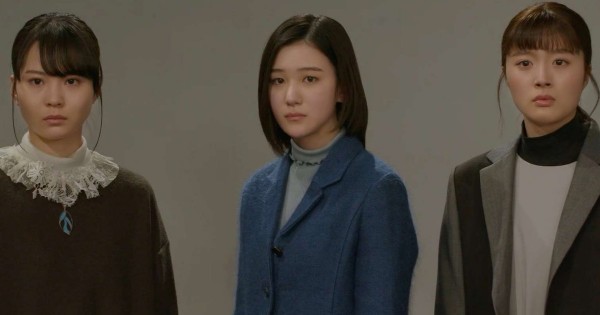
SHUNA IIJIMA, MAYU YAMAGUCHI, AND YUI KITAMURA IN BLUE IMAGINE
URARA MATSUBAYASHI: BLUE IMAGINE (2024)
About women who are victims of male assault; #MeToo in Japan
In 33-year-old Japanese actress Urara Matsubayashi's directorial debut, she deals head-on with the issue of ale sexual violence in the local film industry. In the aftermath of being assaulted by a well-known director, young actress Noel (Mayu Yamaguchi) finds refuge in “Blue Imagine,” a communal living space for abused women. Here, she meets survivors with similar experiences and receives support from a counselor (played by director Matsubayashi). Blue Imagine complexly explores the physical, mental, and emotional scars of abuse, transformative power of friendship, and difficult questions of revenge, recovery and self-realization.
Blue imagine an organization that offers support to those who have suffered sexual abuse and harassment. The young women depicted here meet there.
Two years ago, the lid on the sexual exploitation and harassment that structures the Japanese film industry was finally lifted. It was revealed that directors Hideo Sakaki and Sion Sono had abused their position as director to force sexual "favors." But the power dynamics have not changed. Everything remains very much the same in the Japanese film world.
The focus is on spiring actress Noeru Saito (Mayu Yamaguchi), who is a victim, and her friend Yurina Nishi (Asuka Kawatoko) confesses to her of being verbally and physically assaulted by her sugar daddy.
Guess what? A woman made this film. And it sets out to show that the power dynamics have not changed. Also, the social pressures, even traditional shyness of much of Japanese society, make it hard to speak up against any abuses or pressures exercised on the weak, which includes attractive but powerless young men, who are also shown to suffer sexual assault in the Japanese movie world.
This film is about three women who do what they can. The offending director who is exposed still goes ahead and releases his latest film, but these women show up at the press conference in the concluding scene to challenge him. It's a scene that starts out slowly, but does build up some steam by the end. This film is a quiet milestone in Japanese cinema.
This film will speak to the older generation but it may inspire the younger one to action. It's a clear, simple, straightforward film but it doesn't lecture us. See the Osaka Festival review in PsychoCinematography. Written by Minami Goto, cinematography by Isao Ishii.
Blue Imagine ブルーイマジン, 93 min., debuted at Rotterdam Feb. 2024. Screened for this review as part of the 2024 New York Japan Cuts series (Uul. 10-21).
Last edited by Chris Knipp; 06-25-2024 at 10:51 PM.
-
CHA-CHA (Mai Sakai 2024)
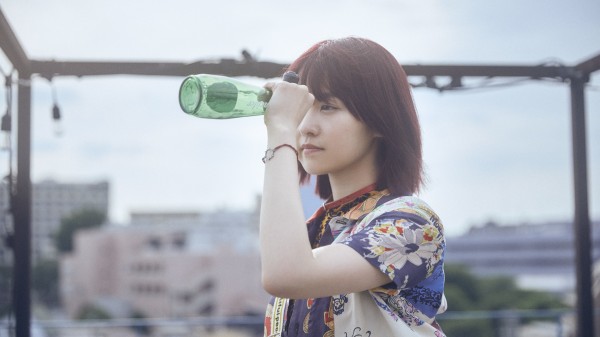
MARIKA ITO IN CHA-CHA
MAI SAKAI: CHA-CHA (2024)
A free-spirited girl comes to the design shop
In this sort-of-femninist rom-com, former Nogizaka46 idol pop star Marika Ito has the lead in the fourth installment of the (not) HEROINE movie series, which also relates to Shinya Tamada's I Am What I Am (JAPAN CUTS 2023). The (not) HEROINE project focuses on up-and-coming actresses and next-generation directors to create films from unique perspectives and non-traditional, female-focused stories. Individual editions may vary.
Cha-Cha is the sort-of-love-story of the titular Cha-Cha, a free-spirited artist who goes to work at a design studio, and Raku (actor and host Taishi Nakagawa), a young cook who is harder to figure out. Cha-Cha is painted with the whimsical colors of a rom-com on the surface but goes on an oddball, deranged digression midway through. Cha-Cha is silly, sweet, screwball, and completely unexpected. See if you think it all makes sense to you.
Raku is a sou-chef in a restaurant on another floor of the building where Cha-Cha comes to work as the new designer/illustrator and the darling of her colorful boss. Raku and Cha-Cha meet in the rooftop smoking area of the building, and eventually he flirts with her and she responds. The pivot point is the gift of a soda drink. On still another floor is the cheery, zoftig Peo (Filipina actress Stefanie Arianne), who teaches English. Her boyfriend (Akihisa Shiono), who never stays at any job, she tells us, also seems unfaithful, leading Raku, when he starts stalking Peo because he loves her eyes, to view him disapprovingly. Very, very disapprovingly, given the action he takes.
Another woman in the office (Sawako Fujima), bespectacled and more conservative in her dress, who envies Cha-Cha's spark and free spirit, not to mention how much the boss favors her, and she starts to spy on her. Cha-Cha paints her work "analog," which others, including the boss, admire. She has an impulsive and frivolous manner and dresses in a unique, eclectic way, favoring a layered-skirt look. Raku is notable for the elegant simplicity of his attire, all-black when at the restaurant, all-white when off-duty. We're not sure that Cha-Cha is really his style, but both have plenty of attitude, and that seems to draw them to each other.
Cha-Cha moves into Raku's busy spread and appears content there. He doesn't seem to love her. He does cook for her, especially his special Mont Michel omelette, and a fantastic soft drink with a cream topping. A montage where they smoke and vape together may not seem very healthy to the US audience, but in a Japanese way it may be bonding of a very high level.
The point of view shifts from one character's voiceover to another as the story unfolds, avoiding any favoritism or feel of a major protagonist, though Cha-Cha sets the style somehow and she does, after all, give her name to the movie. Everything is light and bright for a while, till the two young men's temptation toward unfaithfulness, and some strange ideas about eye lenses and the taste of familiar blood - what is that all about? - start to pull events in a dangerous, potentially violent direction direction (illegal, too). Somehow things right themselves, though, because this remains a lighthearted, superficial, and playful film. At some point it was reminiscent of early Jean-Luc Godard, and it probably would hot exist if he had not made his brilliant and revolutionary films of the 1960's. But the style of revolutionary young people with nothing to be revolutionary about has become as thin and light as a Japanese paper flower by now, and the sprightly, playful tone doesn't fully compensate for the lack of narrative content.
Ito reportedly had a fashion designer mother and a graphic designer father, so she is well cast as an illustrator here. Props to the costume and interior design departments and the composer of the lighthearted score. Fans of manga will like this and sometimes the principals seem to have walked right out of the pages of one.
Cha-Cha チャチャ 108 min., was screened for this review as part of the New York 2024 Japan Cuts series (Jul. 10-21).
SHOWTIME:
Friday, July 19, 2024
9:30 pm
Last edited by Chris Knipp; 07-09-2024 at 10:20 PM.
-
SHADOW OF FIRE (Shin'ya Tsukamoto 2023)

TSUKAO OGA IN SHADOW OF FIRE
SHINYA TSUKAMOTO: SHADOW OF FIRE (2023)
Searing drama of a ravaged post-war Japan
A Letterboxd sage suggests in this movie Tukamoto wanted to make (Elem Limoov's recently revived 1985 tour de force) Come and See, but with a smaller boy. True, this also is a view of the horrors of WWII, with a smaller boy, but there are fewer incidents, by far. The incidents however, except for what seems like some saccharine moments, are powerful and vivid and cut like a knife. The main setting is the black market district in a nameless, Japanese town immediately after the war, and things are very bad, and people are broken. The boy (Tsukao Oga) is an orphan. He sees and has seen and feels and has felt terrible things. He has nightmares. But his eyes are bright and his skin is clear. Not so the others.
At first the boy enters the remains of a tavern where a young woman (Shuri) who, run by a brutal pimp (Go Riju), serves as a prostitute for men who come at night. She takes him in. She also tries to take in an emaciated soldier (Hiroki Kono), pitiful but sweet.
Japan lost the war. That grim truth is embodied in everything, but most of all this soldier, who is badly shell-shocked. How he reacts when there is a loud noise is not something you want to see. He carries a "Second Grade Algebra" reader as a talisman: he was a teacher before the war and he would like to be one again. It doesn't appear he is in any shape to do that. But for a few moments there is this little, sad, faux family, a shred of hope so paltry it seems even more hopeless.
This world is grim, sepulchral, and yet it has a kind of beauty in extremis, like a Samuel Becket play, of finding truth when nothing more can be said. And these tavern scenes are largely like a play. The young prostitute takes the boy to her breast. She offers to see customers only in the daytime, so they can all sleep at night. The ravaged soldier also has said this is the best sleep he has had in a long time. She begs the boy to promise always to be with her.
But that cannot be. The young prostitute turns against the boy, because he has to hustle on the street. He comes back bloody: a mean bigger boy has attacked him to take away money he has earned or things he has stolen. She can't stand that. Her heart is shrunken and warped.
What follows is more like a short story. The boy joins up with what Mark Shilling in his Japan Times review calls "a sketchy black-market hustler" (Mirai Moriyama). This slick gown-garbed man with ponytail is another false family for the boy. But what the boy becomes part of briefly is like an episode in Klimov's Come and See, because he is drawn into a revenge, a dangerous event he cannot escape. The hustler was a soldier and the older man he is after was his superior officer who led him and others into terrible mistreatment of prisoners. He uses the boy as a messenger and also for the pistol he has found in a man's hand and carries in his bag.
There is of course a Message in this revenge, when the hustler explains why he's doing it. But Tsukamoto's screenplay convincingly embeds message in action. All that happens in Shadow of Fire is so intense and brutal we're just happy to get on to the next thing. And then we realize that's what the boy would do. And so he becomes a hustler in the market, and survives. However damaged he may be, here everyone else around him is more so.
Another comparison that may occur, which itself came immediately after the War, is with the great films of Italian Neorealism, Rossellini, Vicconti, Zavatini, De Sica. Shoeshine and Bicycle Thieves are tearjerkers and have small boys in them. But Tsukamoto adds a psychological brutality that is outside the Neorealist range. Shilling points out the boy actor Tsukao Oga is "reminiscent of Yuya Yagira’s turn as an abandoned child in Hirokazu Kore-eda’s 2004 masterpiece, Nobody Knows, and indeed I was reminded of that film. It goes for its emotions faster than the Kore-eda, though, does not have that kind of slow accumulaiton of feeling that hits you as you walk out of the theater. But it's still good, and carries out its powerful work with elegance and economy.
This film has obvious links with Tsukamoto's 2014 Fires on the Plain and 2018 Killing, which premiered in competition in Venice. Also reviewed by Wendy Ide (in Tokyo) for Screen Daily.
Shadow of Fire ほかげ, 95 mins., debuted in the Orizzonti section at Venice Sept. 5, 2023; also Toronto, Tokyo, Taipei. Screened for this review as part of the 2024 New York Japan Cuts series (July 10-21), where it was scheduled as the Centerpiece Film.
Last edited by Chris Knipp; 06-27-2024 at 03:35 PM.
-
GREAT ABSENCE (Kei Chika-ura 2023)
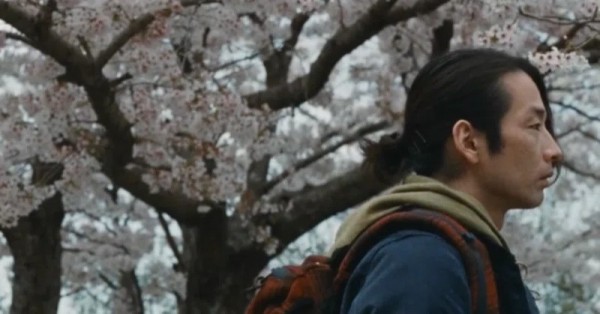
MIRAI MORIYAMA IN GREAT ABSENCE
KEI CHICA-URA: GREAT ABSENCE (2023)
Life of an estranged father with dementia explored like a detective story
Great Absence is a study of dementia, based on the filmkaker's family experience, so deft it gets under your skin, till you thihk you're getting confused, don't know how things work, have fallen out of time. The film jumps around in time, as films do nowadays, but this time it underlines both the disconnect between a father and his estranged son and the father's own loss of connection. Takashi (Mirai Moriyama), is a Tokyo actor who visits his estranged father Yohji (Tatsuya Fuji, winner of a Best Actor award at Saint SebastiŠn for the role) across the country in a care home, coming with his wife producer Yuki (Yoko Maki), where Yohji, now paranoid and wildly fable-weaving, tells them crazy tales to explain what has become of his longtime love, Naomi.
But the film begins with police and excitement at Yohji's home, an alarm he has sent because he has lost his fix on the world. He cannot remember how to work a phone, or a cooker, or a fridge. His basic mental functions have declined so rapidly. And this scene makes the film feel like a detective thriller at first, a process continued as Takeshi and Yuki explore Yohji's disordered house, a jumble of lost objects and post-its trying, uselessly, to help the older man find his way around a familiar world that has grown strange.
The film revisits two earlier moments. Part of the confusion comes from the fact that Takashi and Yohji have long been estranged, but once earlier Takashi visited his father when Naomi was there. Naomi (Hideko Hara), the woman for whom Yohji had left Takashi’s mother many years before is there then. But when the lost, confused Yohji summons the police, she is gone. Where has she gone? Yohji doesn't know, and may not quite remember who she is. At this earlier time, Takashi has recently enjoyed some success in a popular period TV drama, and Naomi reveals that Yohji gets excited for hours whenever this show is going to be on - one of several signs that they care more about each other than their lives have allowed them to acknowledge. Yohji left Takashi's mother for Naomi many years earlier. In the present, when Takashi explores his father's house, he finds a journal of Naomi's stuffed full of love letters from his father: he is discovering a world of feeling neither man shared, and now both are losing.
Takashi seems to have plenty of time, so he stays around exploring these documents and pondering his father's life - which his father in person now is useless as a source for: now that they can be together, there is no there there. This meandering allows the film to be dilatory, and reviews have to acknowledge that it goes on too long. But if the length doesn't work artistically, it certainly helps build our sense of the confusion of dementia. Yohji has long been a ham radio fan. A moment that sticks with me is the one where he comes back from buying a new microphone that he unwraps happily - only to find he already has one just like it. As Jessica Kiang says in her Variety review, " despite being a little long, "in another way its multiple strands and many endings are extraordinarily, poetically appropriate" - because with dementia we are plagued by "a series of erratic goodbyes."
Mirai Moriyama as Takashi, with his sweep of longhair and long forelock hanging down like "William" in Season Two of the great Norwegian series "Skam," makes a very watchable protagonist, but of course it is the old man this is most about, and in his different appearances, even brief ones, the prizewinning Tatsuya Fuji runs the gamut of all the ways dementia can manifest, and seek to hide, itself. This is a devastating and haunting film.
It's also a terribly relevant one, although, since Takashi is an actor in rehearsals for an avant-garde play, if reminds us this syndrome goes back as far as Shakespeare's King Lear. Japan particularly has an aging population, and reportedly now has upwards of six million people with some form of dementia. It could happen to you; but just as bad, it could happen to someone close to you. The irony for Takashi and Yohji is that as they grow closer they are also growing further apart. The worst trick of memory is for memory to leave you. Screenplay by Kei Chika-Ura, Keita Kumano; director Kei also co-wrote and produced his sophomore feature. Cinematography by frequent Hirokazu Kore-eda collaborator Yutaka Yamazaki.
Great Absence 大いなる不在, 152 min., debuted at Toronto Sept. 10, 2023, showing also San SebastiŠn, where Tatsuya Fuji won best performance; plus Vienna, Israel, GŲteborg. Screened for this review as part of the 2024 New York Japan Cuts series.
Last edited by Chris Knipp; 06-30-2024 at 09:01 AM.
-
LOOK BACK (Kiyotaka Oshiyama, 2024)
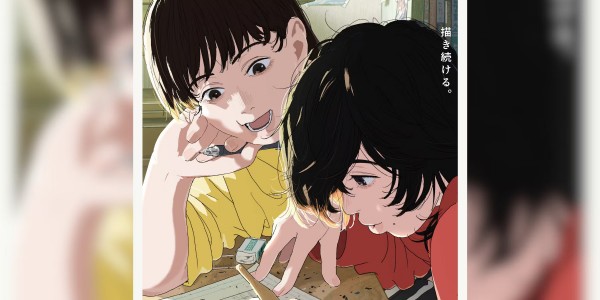
FUJINO (LEFT) AND KIYOMOTO (RIGHT) IN LOOK BACK
KYOTAKA OSHIYAMA: LOOK BACK (2024)
Animation about two girls who become manga artists
This is the story of contrasting schoolgirls Fugino and Kiyomoto who both love drawing manga Japanese comic book art. Ayumu Fujino (voiced by Yuumi Kawai) is confident and attends school, wild-eyed, tousled-haired Kyomoto (Mizuki Yoshida) is a shut-in too shy to talk to a convenience store clerk. They start competing for the four pictures in the weekly school newspaper. Eventually they meet when Fugino is sent to deliver Kiyomoto's school diploma, and Fugino coaxes Kiyomoto out of her shell and they become successful collaborators, Fugino doing the foregrounds and Kiyomoto the backgrounds, winning an award even though they're still in school. When Kiyomoto chooses to go to art university, trouble comes.
Whether the trouble is dire or finds a happy outcome is uncertain since the story is told in several versions. After all, Japan is the home of Rashomon. And this is itself based on a manga book. What is notable is these are two girls who find success in a loving collaboration doing manga art. It's also about the drive to succeed and questioning how to live one's life.
The idea comes up that while Fugino wants to become more skillful at manga - early on a set of drawings sent in by Kiyomoto seems more accomplished - and gets books and fills drawing books with her sketches to improve - her fellow students complain that she is becoming an otaku and not fun anymore. Later when she gives up drawing manga, it seems like a liberating choice. The story about the fascination with manga, anime, and other forms of popular culture also considers that in its extreme form makes someone an otaku, an obsessive. But for a while the two girls become a very successful team, producing one popular series of manga books after another.
Mixed messages here? Yes, but it seems the essence of this kind of storytelling that alternative versions are offered, flashbacks, flash-forwards, fantasies, dreams, and nightmares all considering a subject from different angles and in different moods. The last minutes of the film consist of a series of stills, again depicting Futino and Kiyomoto's happy times of collaboration and friendship.
The violence that comes to one of the girls could be frightening to young readers or viewers, and one of the conclusions is that maybe Kiyomoto should never have been lured from her seclusion. Again one is reminded of the prevalence of reclusive youths in Japan, with now an estimated half million Hikikomori, living shut away with their families. Anyway, Look Back is made up of regrets as much as of successes.
Based on an award-winning manga by Tatsuki Fujimoto, creator of the popular Chainsaw Man,.
Look Back ルックバック ("Rukku Bakku") 56 min., debuted Juh. 10, 2024 at Annecy International Animation Film Festival. Screened for this review as part of the 2024 New York Japan Cuts series (Jul. 10-21).
Last edited by Chris Knipp; 07-09-2024 at 10:18 PM.
 Posting Permissions
Posting Permissions
- You may not post new threads
- You may not post replies
- You may not post attachments
- You may not edit your posts
-
Forum Rules





 Reply With Quote
Reply With Quote








Bookmarks